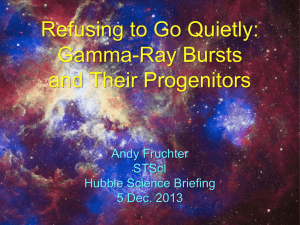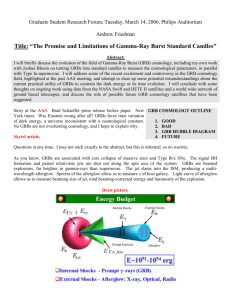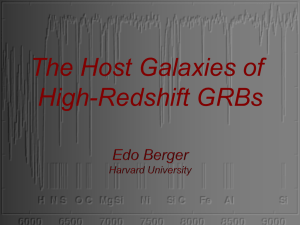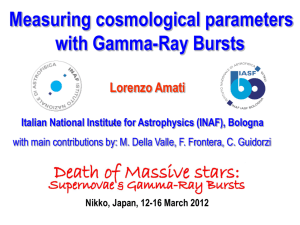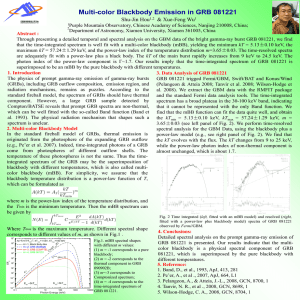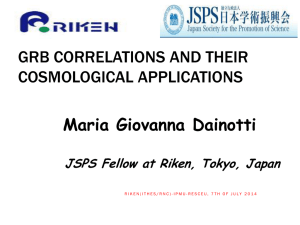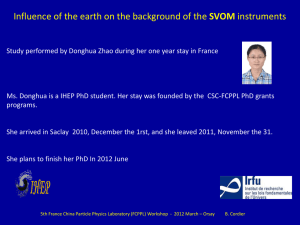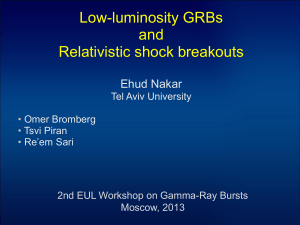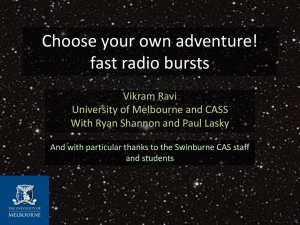ppt
advertisement
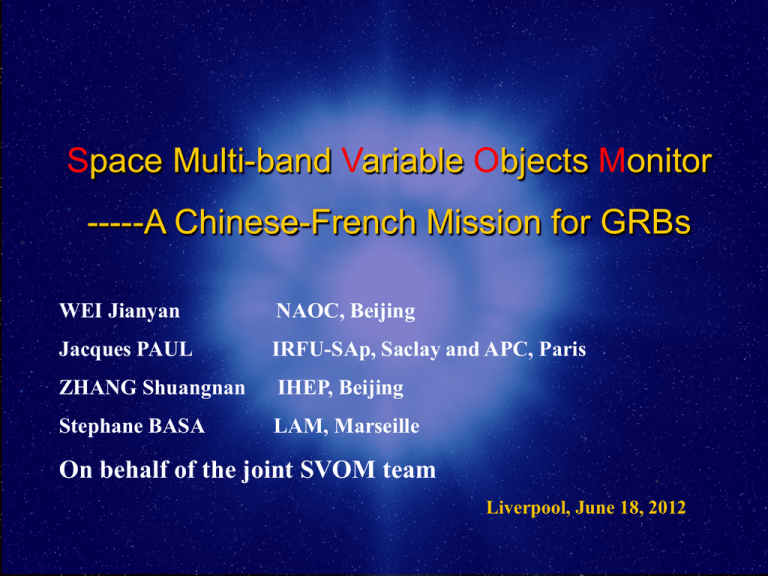
Space Multi-band Variable Objects Monitor -----A Chinese-French Mission for GRBs WEI Jianyan NAOC, Beijing Jacques PAUL IRFU-SAp, Saclay and APC, Paris ZHANG Shuangnan IHEP, Beijing Stephane BASA LAM, Marseille On behalf of the joint SVOM team Liverpool, June 18, 2012 Scientific rationale of a new GRB mission GRB phenomenon GRB physics GRB progenitors Cosmology Fundamental physics Diversity and unity of GRBs Acceleration and nature of the relativistic jet Radiation processes The early afterglow and the reverse shock The GRB-supernova connection Short GRB progenitors Cosmological lighthouses (absorption systems) Host galaxies Tracing star formation Re-ionization of the universe Cosmological parameters Origin of high-energy cosmic rays Probing Lorentz invariance Short GRBs and gravitational waves Scientific requirements on SVOM Permit the detection of all know types of GRBs (>200), with a special care on high-z GRBs and low-z sub-luminous GRBs Provide fast, reliable and accurate GRB positions Measure the broadband spectral shape of the prompt emission (from visible to MeV) Measure the temporal properties of the prompt emission Quickly identify the afterglows of detected GRBs, including those that are highly redshifted (z>6) Quickly provide (sub-) arcsec positions of detected afterglows Quickly provide redshift indicators of detected GRBs Proposed scientific instruments ECLAIRs, the X-ray and soft gamma-ray trigger camera 4-250KeV 2sr (90*90 deg) GRM, the gamma-ray spectro-photometer 50KeV-5MeV 2sr MXT, the micro-channel soft X-ray telescope 0.3-5KeV 65’65’ VT, the visible telescope 400-650nm, 650-950nm 26’26’ GWAC, an array of ground wide angle cameras 450-900nm 2sr C-GFT, the Chinese ground follow-up telescope 400-1000nm? 25’25’ F-GFT, the French ground follow-up telescope 400-1700nm 30’30’ GRM VT MXT ECLAIRS GWAC GFTs Eclairs: the trigger 2-D coded mask (30% transparency) Passive shield to block X-ray background 200 modules of 32 CdTe detectors (4 mm × 4 mm) Useful area: 1024 cm2 Field of view: 2 sr Spectral domain: 4 keV to 300 keV ECLAIRs: the trigger camera Main design objective Counts 300 3.5 keV 200 A low energy threshold in the X-ray domain 100 0 10 20 30 40 50 60 Energy (keV) Simulated sensitivity ECLAIRs expected to be more sensitive than SWIFT (BAT) for GRBs whose peak energy is < 20 keV ECLAIRs – Anticipated performances 100 SWIFT (bright) SWIFT Fraction > z (%) 80 ECLAIRs 60 40 DATA (SWIFT) 20 0 0 2 4 6 Redshift z 8 10 Simulated redshift distribution of long GRBs to be detected by ECLAIRs Nearly 10-20% of ECLAIRs GRBs could be situated at high redshift (z > 6) GRM: the Gamma-Ray Monitor Scintillation (phoswich) detector NaI (10 mm thick) + CsI (40 mm thick) FoV: Useful area: 2 modules 2 sr 280 cm2 per module Spectral Domain: 50 keV to 5 MeV Measurement of Epeak (up to ~ 500 keV) ECLAIRs + GRM: Epeak ~ 10-500keV MXT: to provide the accurate positioning Micro-Channel optics CCD camera passively cooled Field of view: 65 arc min × 65 arc min Spectral domain: 0.3 keV to 5 keV Useful area: 52 cm2 at 1 keV Detected GRBs to be localized with an error ~ 30 arc sec Sensitivity: Comparison with Swift/XRT MXT can detect ~90% of the afterglows VT:the Visible Telescope Modified R-C optical design Aperture size : 450 mm Focal length: 3600mm Field of View: 26 arc min × 26 arc min Bands: 400-650 nm & 650-950 nm Afterglow emission detection down to MV ~ 23 (300 s exposure) VT: the visible telescope Cumulative probability 1.0 VT-SVOM 0.8 0.6 0.4 UVOT-SWIFT 0.2 Akerlof & Swan, ApJ 671, 1868, 2007 0.0 12 14 16 18 20 22 Magnitude at 1000 seconds 24 The intrinsic cumulative GRB apparent optical afterglow distribution To detect ~ 80% of the observed GRBs Space instruments performances Spectral band Field of View Allocation Accuracy GRBs/yr (Dect. Rate) GRM 50keV-5MeV 2 sr Not applicable ~100 ECLAIRs 4-250 keV 2 sr 10 arcmin ~80 MXT 0.3-5 keV 65 65 arcmin 30 arcsec ~90% VT 400-650 nm 650-950 nm 26 26 arcsec 1 arcsec ~80% Parameters of GWAC Cameras: 72 Diameter: 180mm Focal Length: 213mm Wavelength: 450-900nm Total FoV: 9000Sq.deg Limiting Mag: 16.5V(5,10sec) Prompt optical emission detection down to MV ~ 16.5 (10 s exposure) Combined optical light curve Kann et al 2010 GWAC GFT T-t0=30 sec VT Pointing strategy: anti solar Sun Night side Sun Night side Sun SVOM orbit (i ~ 30°) Night side About 75% of the GRBs detected by SVOM to be well above the horizon of large ground based telescopes all located at tropical latitudes Prompt dissemination of the GRB parameters VHF Network GRB observation strategy Space GRB trigger provided by ECLAIRs at time T0 T0 + 5 min VT (V & R band photometry) MXT (Soft X-ray photometry) T0 +1 min Ground 1-2 m robotic telescopes GWAC GFTs (g, r, i, J, H) Multi messenger follow-up Frequency (Hz) Frequency (Hz) Multi-wavelength capabilities of SVOM 1022 Space GRM ECLAIRs 1020 1018 1016 MXT VT Slew 1014 Groun d 1015 GWAC C-GFT F-GFT 1014 -5 0 Time (m) Lin. scale 1 10 102 103 Time (s) Log. scale 104 105 SVOM compared with Swift Prompt emission measurement Afterglow emission measurement More sensitive below 20keV (to 4keV) Better Epeak measurement capability Prompt optical emission 10 times more sensitive in the visible, additional 650-950 nm band Ground follow-up observation Two dedicated 1meter telescopes with NIR dectector GRBs more easily scrutinized by the largest telescopes Hunting for high-z GRBs SVOM is going to provide redshift indicators to GCN Eclairs + GRM: pseudo redshift VT: redshift indicator: z<4.2, 4<z<6.0, z>6.0 or “dark” GFTs: photometric redshift Ground near Infrared telescopes are encouraged to point promptly to the GRBs which are detected by MXT in X-ray, but not by VT ! (~10 per year) Status of the SVOM mission 2005 Sino-French discussions (CNES-CNSA) on a mini satellite mission Scientific discussions on the SVOM mission for GRB studies 2006 SVOM Phase 0 kick-off meeting (March, Toulouse) SVOM phase 0 review (Sept., Shanghai) – No critical issue CNSA/CNES MoU signed during the President visit (Oct., Beijing) 2007 SVOM Phase A kick-off meeting (March, Xi’an) SVOM mission approved by CNES SPC (April, Paris) 2008 SVOM Phase A review meeting (Oct., Beijing) 2009 SVOM proved by CNES France 2010 SVOM funded by CNSA China SVOM launch at Kulu, the only mission to deliver GRB localization 2016 (?) 谢 谢!
